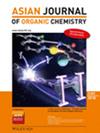2,5-双(2-苯并咪唑)对苯二酚超快激发态双质子转移的实验与理论探讨
IF 2.8
4区 化学
Q1 CHEMISTRY, ORGANIC
引用次数: 0
摘要
采用实验和理论相结合的方法研究了2,5-双(2-苯并咪唑)对苯二酚(bis-HBI)在非极性溶剂中的电子性质和激发态双质子转移。成功合成了Bis-HBI,并通过1H NMR和FT-IR对其进行了表征。在484,597和730 nm处观察到三个不同的发射峰,理论上分别属于二烯醇(EE)、单酮(EK)和双酮(KK)物质。波长较长的发射峰(597 nm和730 nm)归因于光激发下的互变异构,并被分配给单酮和双酮物质,这是由多个质子转移引起的。这些物种表现出动力学和热力学上的有利行为。动态模拟表明,双质子转移过程发生得非常快,在433秒内。此外,在第一和第二质子转移过程中,观察到质子正向和反向转移,表明在激发态表面上,三种物质(ee, EK和kk)之间存在互变异构平衡。这与沿质子转移坐标的势能面是一致的。本文章由计算机程序翻译,如有差异,请以英文原文为准。
Experimental and Theoretical Exploration of Ultrafast Excited State Double Proton Transfer in 2,5‐Bis(2‐benzimidazolyl)hydroquinone
The electronic properties and excited‐state intramolecular double proton transfer of 2,5‐bis(2‐benzimidazolyl)hydroquinone (bis‐HBI) in a nonpolar solvent were investigated using a combined experimental and theoretical approach. Bis‐HBI was successfully synthesized and its characterization was confirmed through 1H NMR and FT‐IR. Three distinct emission peaks of bis‐HBI were observed at 484, 597, and 730 nm, which were theoretically assigned to the di‐enol (EE), mono‐keto (EK), and di‐keto (KK) species, respectively. The emission peaks at longer wavelengths (597 and 730 nm) are attributed to tautomerization upon photoexcitation and are assigned to the mono‐keto and di‐keto species, which result from multiple proton transfers. These species exhibit kinetically and thermodynamically favorable behaviors. On‐the‐fly dynamics simulations reveal that the double proton transfer process occurs ultrafast, within 433 fs. Additionally, both backward and forward proton transfers are observed during the first and second proton transfers, indicating tautomeric equilibria between the three species—EE, EK, and KK—on the excited‐state surface. This is consistent with the potential energy surface along the proton transfer coordinate.
求助全文
通过发布文献求助,成功后即可免费获取论文全文。
去求助
来源期刊

Asian Journal of Organic Chemistry
CHEMISTRY, ORGANIC-
CiteScore
4.70
自引率
3.70%
发文量
372
期刊介绍:
Organic chemistry is the fundamental science that stands at the heart of chemistry, biology, and materials science. Research in these areas is vigorous and truly international, with three major regions making almost equal contributions: America, Europe and Asia. Asia now has its own top international organic chemistry journal—the Asian Journal of Organic Chemistry (AsianJOC)
The AsianJOC is designed to be a top-ranked international research journal and publishes primary research as well as critical secondary information from authors across the world. The journal covers organic chemistry in its entirety. Authors and readers come from academia, the chemical industry, and government laboratories.
 求助内容:
求助内容: 应助结果提醒方式:
应助结果提醒方式:


